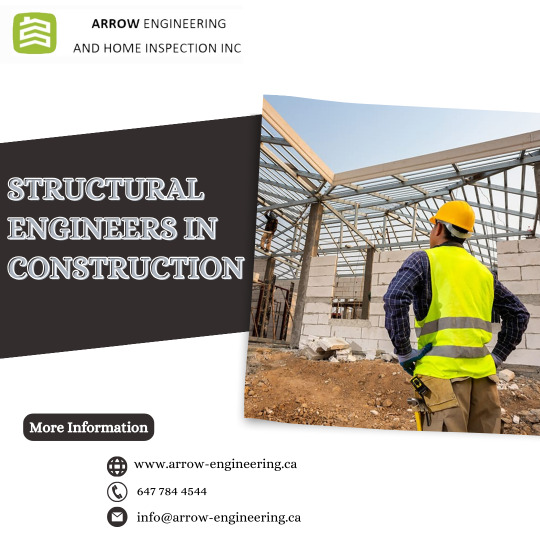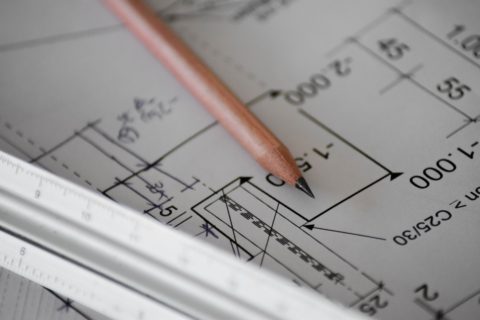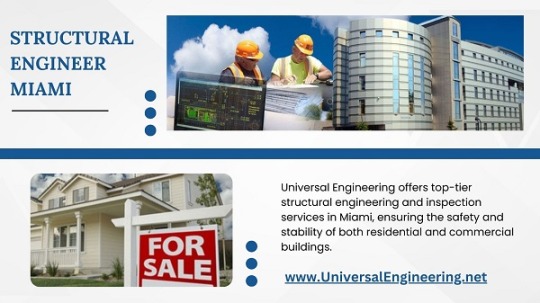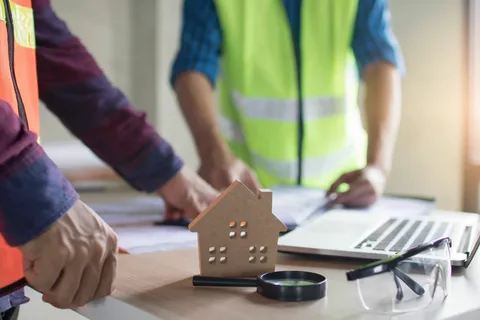#Structural Engineer Inspection
Text

The Role and Importance of Structural Engineers in Construction
Structural engineers play a pivotal role in the construction industry, providing the safety, stability, and durability of buildings and infrastructure. Their expertise is essential in every phase of a construction project, from the initial design to the completion of the structure. In Toronto, as in many other cities, structural engineers are in high demand, providing a range of services for both residential and commercial projects.
Structural Analysis, Design, and Drawing Preparation
One of the primary responsibilities of a structural engineer is to perform structural analysis, design, and drawing preparation. This involves determining the structural integrity of a building or infrastructure project, calculating the loads that the structure will need to support, and designing the framework to ensure its stability and safety.
Structural engineers use advanced software and mathematical calculations to analyze the structural elements of a building, such as beams, columns, and foundations. Based on this analysis, they develop detailed design drawings that specify the size, shape, and placement of structural components. These drawings serve as a blueprint for the construction process, guiding contractors and builders in the assembly of the structure.
In Toronto, structural engineers are responsible for ensuring that buildings meet the requirements of the Ontario Building Code and other relevant regulations. They work closely with architects, contractors, and other professionals to create safe and efficient structures that meet the needs of their clients.
Construction Supervision and Inspection
Another critical role of structural engineers is construction supervision and inspection. Throughout the construction process, they monitor the progress of the project to ensure that it is being built according to the design specifications. This includes overseeing the work of contractors, conducting site visits, and performing quality control inspections.
During construction, structural engineers may encounter unforeseen challenges or issues that require immediate attention. They are responsible for finding solutions to these problems and ensuring that the project stays on track. By providing expert guidance and oversight, structural engineers help to prevent costly delays and ensure that the final structure meets all safety and quality standards.
Design of Solar Power Structural Mounting Systems
With the growing emphasis on renewable energy, structural engineers are increasingly involved in the design of solar power structural mounting systems. These systems support solar panels and ensure that they are securely attached to the roof or ground. Structural engineers must consider factors such as wind loads, snow loads, and seismic activity when designing these mounting systems to ensure their stability and durability.
In Toronto, where the demand for solar energy is on the rise, structural engineers play a crucial role in helping property owners harness the power of the sun. By designing efficient and reliable mounting systems, they make it possible for homes and businesses to generate clean, renewable energy and reduce their carbon footprint.
Assessment and Design Solutions for Structural Issues
Finally, structural engineers are called upon to assess and provide design solutions for structural issues that arise during the construction process or after a structure is built. This could include problems such as cracks in the foundation, sagging floors, or structural instability.
Using their expertise in structural analysis and design, engineers can diagnose the underlying cause of the issue and develop a plan to address it. This may involve reinforcing the existing structure, making repairs, or in some cases, redesigning portions of the building to improve its stability and safety.
In conclusion, structural engineers play a critical role in the construction industry, ensuring that buildings and infrastructure projects are safe, stable, and built to last. From the initial design phase to the structure's completion, their expertise is essential in every step of the process. In Toronto, as in other cities around the world, structural engineers are at the forefront of innovation, helping to create the buildings and infrastructure of the future.
#Structural Engineer in Mississauga#Structural Engineer in Residential#Pre-Inspection Program in Toronto#Structural Engineering in Ajax#Structural Engineer Inspections#Structural Engineer Inspection
0 notes
Text
In residential construction, one figure stands as the linchpin of structural integrity: the structural engineer. With a keen eye for detail and a deep understanding of architectural design, these professionals play a pivotal role from conception to completion. Their expertise in analyzing designs, selecting materials, and ensuring compliance with regulations forms the bedrock upon which safe and durable homes are built.
0 notes
Text
Learn What the Auditors Do at the Time of Energy Audit
At the time of Energy Audit New York, in addition to the airtightness test, an energy auditor will conduct a thermo graphic scan to measure the energy use of your business or house. Furthermore, they will measure energy use with a variety of devices, including infrared cameras, surface thermometers, and furnace efficiency meters. Finally, the auditor will review previous utility bills.
Phone No. (888) 343-0713
Email: [email protected]
Address: 515 E Las Olas Blvd Suite 120, Fort Lauderdale, FL 33301, USA
#Structural Engineer#Structural Inspection#Engineering Company#Structural Engineer Near Me#Engineers Near Me#Building Engineer#Structural Engineer Inspection#Engineering Services#Structural Engineering Services#Engineering Firms Near Me#Energy Audit San Francisco#Local Law 11 Inspection#Energy Audit New York
0 notes
Text

Structural Inspection Services
Elevate your property's safety and value with expert structural inspection. Our thorough assessments ensure a detailed analysis of your building's integrity. Trust us for reliable insights and peace of mind. Schedule our professional structural inspection today!
0 notes
Text
A Complete Guide To 40 Year Recertification For Condo Buildings (Miami-Dade and Broward)
A 40 year recertification in the counties of Miami-Dade and Broward is a legal requirement for both building owners and condo associations. And as a resident or owner of a condo unit, you should definitely keep track of your building’s recertification timeline and press the association for timely compliance.
After all, the legal ramifications, as well as the safety consequences of not getting timely recertification, are much higher than the cost of recertification.
Looking to get a 40 year inspection for your condominium?
You can reach out to us.
At Souffront Construction and Engineering, we are a team of seasoned structural engineers and inspectors registered in the state of Florida. So whatever your building type and size, you can rely on for an all-inclusive inspection and post-inspection support.
0 notes
Text
#structural inspection#structural engineer inspection#structural engineer inspection cost#structural engineer home inspection#structural inspection cost#structural home inspection#structural engineer inspection near me#structural engineer house inspection
0 notes
Text
Architectural Design and Planning Services in NYC
As a full service design firm, architectural design and planning is a cornerstone of our service. Our people have the expertise to design and develop exterior, interior, and space planning, LEED design and existing design rehabilitation. Our architectural staff collaborates with the structural design team, HVAC contractors, and plumbing and electrical professionals to provide a complete solution to all of your architectural design and planning needs. Our goal is to work within your budget, deliver projects according to schedule, and optimize your design needs.

#Architectural Design and Planning Services in NYC#Architectural Design Services in NYC#Geotechnology Drilling Services in NYC#Geotechnology Soil boring Services in NYC#geotech#Soil boring And Drilling Services in NYC#structural engineering design services#architects and building designer#architects and building designer in nyc#architecture building design#structural engineer#structural engineering#architectural design firm in nyc#building structural engineering services#best structural design engineering firm in nyc#building design#Construction Inspection Services in NYC#Construction Material Testing Services in NYC#Material Testing Services in NYC
4 notes
·
View notes
Text
Enhancing Safety and Stability: Structural Engineering and Inspection Services in Miami

Miami, known for its vibrant culture and stunning architecture, is also a region prone to unique structural challenges. From hurricane-force winds to high humidity levels, buildings in Miami must withstand a variety of environmental stresses. Ensuring the integrity and safety of these structures requires the expertise of seasoned professionals. This is where Universal Engineering comes in, offering exceptional structural engineering and inspection services.
Universal Engineering, a leading firm in the industry, specializes in providing comprehensive structural engineering solutions. Their services include structural design, analysis, and repair for both residential and commercial properties. What sets Universal Engineering apart is their unwavering commitment to quality and safety. Their team of award-winning engineers brings a wealth of experience and knowledge to every project, ensuring that every structure they work on meets the highest standards of safety and stability.
One of the core services offered by Universal Engineering is Structural Inspection. Regular structural inspections are crucial for identifying potential issues before they become major problems. In Miami, where environmental conditions can take a toll on buildings, these inspections are even more critical. Universal Engineering’s thorough inspection process includes a detailed assessment of the building’s structural components, such as foundations, beams, and columns. By conducting these inspections, they can detect signs of wear, damage, or stress that might compromise the building’s integrity.
In addition to inspections, Universal Engineering also offers building damage assessments. Following severe weather events or other incidents, their engineers are on hand to evaluate the extent of any damage and recommend appropriate repair solutions. This service is invaluable in ensuring that buildings can be quickly and safely restored to their original condition, minimizing downtime and disruption for owners and occupants.
Moreover, Universal Engineering’s expertise extends to concrete and steel design, foundation work, and the design of structural systems. Whether it’s a new construction project or the renovation of an existing building, their engineers apply state-of-the-art techniques and best practices to deliver robust and reliable structures.
For those in Miami seeking reliable and expert Structural Engineering and Inspection Services, Universal Engineering stands out as a trusted partner. Their dedication to excellence, combined with their deep understanding of the unique challenges posed by the local environment, makes them the go-to choice for ensuring the safety and longevity of any building.
0 notes
Text
youtube
#youtube#militarytraining#Bridge renovation#Bridge collapse#Bridge safety#Civil engineering#Bridge inspection#Bridge demolition#Structural engineering#Bridge repair#Bridge maintenance#Bridge design#Infrastructure#Heavy machinery#Bridge replacement#Destruction#Precision cutting#Construction technology#Engineering marvel#Bridge construction#Bridge destruction.#Demolition techniques#Bridge engineering
0 notes
Text
Understanding Structural Engineer House Inspection Costs

When considering a structural engineer for your house inspection, understanding the cost is crucial. You may make wise selections by using This guide, which breaks down the variables affecting structural engineer house inspection cost. Learn about typical rates, scope of services, and how to get accurate quotes for your specific needs.
0 notes
Text
#Structural Engineer in Toronto ON#Architectural Designer in Toronto ON#Structural Engineer Inspection near me#Foundation Structural Engineer near me#Structural Repair near me
1 note
·
View note
Text
Ensuring Structural Integrity Through Engineering and Inspections

Structural engineering and inspections involve the analysis, design, and evaluation of structures to ensure they meet safety, durability, and performance standards.
Structural Engineering
Structural Analysis: Determining how structures will respond to various loads and forces, including gravity, wind, earthquakes, and temperature fluctuations.
Design and Planning: Creating detailed plans and specifications for the construction or renovation of structures, ensuring they meet building codes and regulations.
Material Selection: Choosing appropriate materials based on structural requirements, environmental conditions, and project specifications.
Foundation Design: Designing foundations to support the structure safely and efficiently, considering soil conditions and load-bearing capacity.
Structural Elements: Designing and specifying structural elements such as beams, columns, slabs, and walls to ensure they can withstand anticipated loads.
Computer-Aided Design: Utilizing computer software for modeling and simulation to analyze and optimize structural designs.
Construction Oversight: Provide on-site supervision and guidance during construction to ensure that the structural elements are implemented according to the design.
Structural Retrofitting: Strengthening or modifying existing structures to enhance their load-carrying capacity or to meet new design requirements.
Structural Inspections
Visual Inspections: Conducting visual examinations of structures to identify any visible signs of damage, deterioration, or structural issues.
Material Testing: Performing tests on materials (e.g., concrete, steel) to assess their quality and integrity.
Non-Destructive Testing: Using techniques such as ultrasound, X-rays, and thermal imaging to detect hidden structural flaws without causing damage.
Code Compliance Checks: Verifying that the structure complies with local building codes, regulations, and safety standards.
Safety Inspections: Assessing the overall safety of a structure, including the condition of stairs, railings, and other safety features.
Environmental Impact Assessments: Evaluating the environmental impact of the structure, considering factors like energy efficiency and sustainability.
Report Generation: Providing detailed inspection reports outlining findings, recommendations, and necessary remedial actions.
Post-Disaster Assessments: Conduct assessments after natural disasters to determine the structural integrity of buildings and recommend repair or reconstruction strategies.
Structural engineering and inspections are critical components of the construction and maintenance process, ensuring that structures are safe, resilient, and compliant with industry standards and regulations. These processes play a key role in safeguarding public safety and the longevity of built environments.
#structural engineer inspection#residential structural engineer#structural engineer#structural engineer home inspection#pre inspection program in toronto
0 notes
Text
Innovating Pipeline Rehabilitation: Pipe CIPP Lining Engineering Design Services as per ASTM F1216
In the dynamic world of plumbing and pipe rehabilitation, Cured-In-Place Pipe (CIPP) lining stands as a testament to the industry's progress and innovation. Pioneering a non-invasive, cost-effective, and efficient approach to pipeline repair, CIPP lining engineering design services have carved a significant niche in the industry. Adherence to the ASTM F1216 standard, set by the American Society for Testing and Materials, has further cemented the integrity and reliability of these services.
CIPP Lining: A Brief Overview
CIPP lining is a trenchless rehabilitation method that effectively repairs existing pipelines without the need for excavation. This process involves inserting and running a felt lining into a pre-existing pipe that is impregnated with a specially formulated resin. This resin is then cured, essentially creating a "pipe within a pipe."
The CIPP method addresses a wide array of issues, such as leaks, corrosion, root intrusion, and age-related wear and tear, without disrupting the landscape or the daily activities of businesses or households.
CIPP Lining Engineering Design Services
CIPP lining engineering design services employ advanced technology and innovative engineering principles to create effective, long-lasting solutions for pipeline problems. These services are critical to accurately assessing the damage, designing the CIPP liner, implementing the solution, and ensuring successful pipeline rehabilitation.
These engineering design services consist of various steps, such as:
Inspection: Before any design work can begin, the pipe's condition needs to be assessed using closed-circuit television (CCTV) inspection and other technologies. This inspection enables engineers to evaluate the damage extent and pinpoint its location.
Design: Based on the inspection, engineers design the CIPP liner considering factors such as pipe diameter, length, material, operating conditions, and the type and extent of damage.
Installation: This step involves inserting the designed liner into the damaged pipe and curing it using hot water, steam, or UV light.
Post-installation Inspection: The final step involves inspecting the rehabilitated pipe to ensure the CIPP liner is correctly installed and functioning as expected.
The Role of ASTM F1216
The ASTM F1216 - "Standard Practice for Rehabilitation of Existing Pipelines and Conduits by the Inversion and Curing of a Resin-Impregnated Tube," is a globally recognized standard that guides the CIPP lining process. It prescribes the material requirements, resin preparation, inversion process, curing method, and testing techniques for CIPP lining.
Adherence to this standard ensures that the CIPP lining engineering design services meet the necessary quality and safety standards. It also guarantees the end product's durability, structural integrity, and optimal functionality.
Benefits of CIPP Lining Engineering Design Services
CIPP lining engineering design services offer numerous benefits, such as:
Durability: CIPP linings have a lifespan of up to 50 years, making them a long-lasting solution.
Non-disruptive: Being a trenchless method, CIPP lining causes minimal disruption to daily activities and avoids damaging landscapes or structures.
Versatility: CIPP lining is suitable for various pipe materials and diameters, making it a versatile solution.
Cost-effective: CIPP lining eliminates the need for excavation and extensive manual labor, significantly reducing costs.
Efficiency: The entire CIPP lining process can often be completed in a day, making it an efficient solution for pipeline rehabilitation.
Among the many engineering firms providing CIPP lining design services, Little P.Eng. Engineering has distinguished itself as a leader. Leveraging a combination of industry expertise, innovation, and adherence to the ASTM F1216 standard, the firm has been able to provide high-quality, efficient, and reliable pipeline rehabilitation services.
Firstly, the firm's deep-rooted understanding of pipeline systems is undeniable. They have a team of dedicated professional engineers (P.Eng.) who bring a wealth of knowledge and experience to the table. Their engineers understand the intricacies of different pipeline materials, their response to various environmental conditions, and potential failure modes.
Their specialization in CIPP lining, a modern, trenchless pipeline rehabilitation method, has allowed them to handle a broad range of pipeline issues effectively. Whether it's handling minor leaks, major corrosion issues, or extensive root intrusion, their team is adept at designing and implementing the appropriate CIPP lining solution.
Adherence to the ASTM F1216 standard has been a cornerstone of Little P.Eng. Engineering's approach to CIPP lining engineering services. This commitment ensures that the resin preparation, inversion process, curing methods, and testing techniques used meet the highest quality and safety standards. It also guarantees that the resulting CIPP lining possesses the durability, structural integrity, and functionality necessary for long-term pipeline performance.
Moreover, Little P.Eng. Engineering is known for its innovative approach. They harness the latest technologies and engineering principles to improve the effectiveness and efficiency of their CIPP lining design services. This includes using state-of-the-art CCTV technology for initial pipeline inspection and advanced curing methods to ensure optimal resin curing.
Lastly, the firm's dedication to customer satisfaction sets them apart. They understand that every client has unique needs and circumstances, and they strive to provide tailored solutions that are both effective and cost-efficient. They also prioritize transparent communication, ensuring their clients understand every aspect of the rehabilitation process.
In conclusion, Little P.Eng. Engineering's deep expertise, innovative approach, and commitment to customer satisfaction make them a preferred choice for CIPP lining engineering design services. Their rigorous adherence to ASTM F1216 further assures clients that they are receiving high-quality, safe, and durable pipeline rehabilitation solutions. The combination of these factors positions Little P.Eng. Engineering as a reliable partner in the industry, capable of effectively addressing a wide array of pipeline challenges.
Conclusion
In the realm of plumbing and pipeline rehabilitation, CIPP lining engineering design services as per ASTM F1216 have proven to be a game-changer. By providing a non-invasive, cost-effective, and efficient solution to pipe repair, they have redefined traditional methods. As the industry continues to innovate, the importance of these services and the ASTM F1216 standard's adherence will only grow, paving the way for a future where pipeline problems are no longer a headache but a manageable, efficient process.
Read More:
Innovating Pipeline Rehabilitation: Pipe CIPP Lining Engineering Design Services as per ASTM F1216
Pipeline Rehabilitation Engineering Design Services as per ASTM F1216 Using CIPP and PVC
Little P.Eng. Engineering For CIPP Liner Design As Per ASTM F1216 Using Finite Element Method
Revolutionizing Pipe Rehabilitation: Little P.Eng. Engineering's Mastery of CIPP Liner Design via Finite Element Method in Accordance with ASTM F1216
Tags:
Meena Rezkallah
Little P.Eng. Engineering
ASTM F1216
Professional Engineers
Pipe Rehabilitation
CIPP Lining
Engineering Design Services
Trenchless Technology
Pipeline Repair
Cured-In-Place Pipe
Resin-Impregnated Tube
Plumbing Industry Innovation
Pipe Lining Solutions
Pipeline Inspection
Durability and Structural Integrity
Cost-Effective Pipeline Solutions
Engineering Services
Pipe Rehabilitation
Located in Calgary, Alberta; Vancouver, BC; Toronto, Ontario; Edmonton, Alberta; Houston Texas; Torrance, California; El Segundo, CA; Manhattan Beach, CA; Concord, CA; We offer our engineering consultancy services across Canada and United States. Meena Rezkallah.
#Meena Rezkallah#Little P.Eng. Engineering#ASTM F1216#Professional Engineers#Pipe Rehabilitation#CIPP Lining#Engineering Design Services#Trenchless Technology#Pipeline Repair#Cured-In-Place Pipe#Resin-Impregnated Tube#Plumbing Industry Innovation#Pipe Lining Solutions#Pipeline Inspection#Durability and Structural Integrity#Cost-Effective Pipeline Solutions
0 notes
Text
Learn What the Auditors Do at the Time of Energy Audit
A home or business building's energy efficiency is assessed through an Energy Audit San Francisco. Energy efficiency, expressed simply, is the use of less energy to accomplish the same task. You will receive a comprehensive assessment of your energy efficiency and electricity consumption from the audit.
Phone No. (888) 343-0713
Email: [email protected]
Address: 515 E Las Olas Blvd Suite 120, Fort Lauderdale, FL 33301, USA
#Structural Engineer#Structural Inspection#Engineering Company#Structural Engineer Near Me#Engineers Near Me#Building Engineer#Structural Engineer Inspection#Engineering Services#Structural Engineering Services#Engineering Firms Near Me#Energy Audit San Francisco#Local Law 11 Inspection#Energy Audit New York
0 notes
Text
Commercial Real Estate Inspector
Seeking a reliable commercial real estate inspector? Look no further than RSH Engineering & Construction. Our thorough inspections ensure your property meets industry standards and regulations.
#commercial real estate inspector#engineer house inspection#structural home inspection#structural damage inspection
0 notes
Text
Here’s How Condo Associations Can Go About 40 Year Recertification In Miami-Dade
You see, even as Florida’s lenient laws mean individual condo unit owners can vote not to increase the HOA fee for recertification inspection, it certainly isn’t the best thing to do.
So, if you’re a condo owner, you should frequently check with the association and get the 40 year structural inspection completed on time.
0 notes